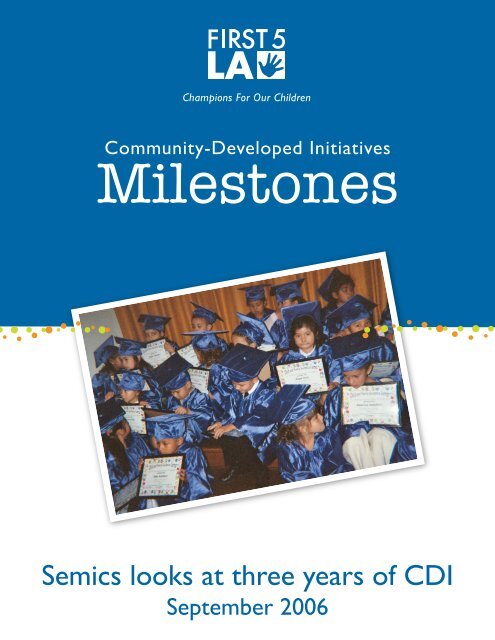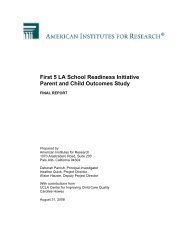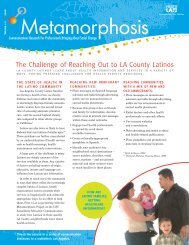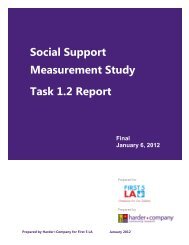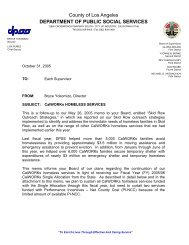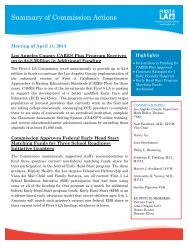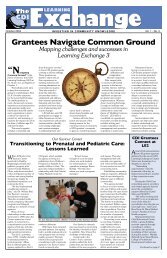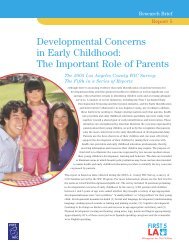Semics Looks at Three Years of CDI (September 2006) - First 5 LA
Semics Looks at Three Years of CDI (September 2006) - First 5 LA
Semics Looks at Three Years of CDI (September 2006) - First 5 LA
- No tags were found...
You also want an ePaper? Increase the reach of your titles
YUMPU automatically turns print PDFs into web optimized ePapers that Google loves.
Champions For Our ChildrenCommunity-Developed Initi<strong>at</strong>ivesMilestones<strong>Semics</strong> looks <strong>at</strong> three years <strong>of</strong> <strong>CDI</strong><strong>September</strong> <strong>2006</strong>
Champions For Our ChildrenCommunity-Developed Initi<strong>at</strong>ivesIntroductionIn the period from 2002-2003, 54 agencies were selected by <strong>First</strong> 5 <strong>LA</strong>’s Community-DevelopedIniti<strong>at</strong>ives (<strong>CDI</strong>) through a competitive solicit<strong>at</strong>ion process, to improve the lives <strong>of</strong> children 0- 5 and their families. The initi<strong>at</strong>ive’s purpose was to implement various approaches to supportsystemic, long-lasting changes in the wellbeing <strong>of</strong> children and their families in Los Angeles County.<strong>Three</strong> years l<strong>at</strong>er, these agencies have achieved results defined as a priority in <strong>First</strong> 5 <strong>LA</strong>’s Next FiveStr<strong>at</strong>egic Plan.<strong>CDI</strong> Milestones highlights these achievements beginning with the legacy th<strong>at</strong> <strong>CDI</strong> grantees leavebehind in Los Angeles communities, specifically their impacts on children, families, neighborhoods,agencies and the grantees themselves. Referring to key themes <strong>of</strong> the Next Five Str<strong>at</strong>egic Plan, thisdocument presents <strong>CDI</strong> results in detail focussed around three interrel<strong>at</strong>ed goal areas — EarlyLearning, Health, and Safe Children and Families and two programm<strong>at</strong>ic str<strong>at</strong>egies — CapacityBuilding and Systems Improvement. These results include numbers <strong>of</strong> children, families and childcare providers impacted by the <strong>CDI</strong>-funded projects since the beginning <strong>of</strong> <strong>CDI</strong>, numbers which wereeither provided by the grantees or cited in their progress reports. Pictures, quotes and vignettes areincluded to render a textured, panoramic view <strong>of</strong> wh<strong>at</strong> has been achieved. We also highlight “ahamoments” and insights demonstr<strong>at</strong>ing the value <strong>of</strong> these <strong>CDI</strong>-funded projects to participants andproject staff.<strong>CDI</strong> achievements are described from the perspectives<strong>of</strong> <strong>First</strong> 5 <strong>LA</strong>, <strong>CDI</strong> Grantees, and <strong>Semics</strong> staff. Them<strong>at</strong>erial in this document is derived from varioussources including site visits, interviews, focus groups,surveys conducted by <strong>Semics</strong> from January 2004 to<strong>September</strong> <strong>2006</strong>, grantee reports to <strong>First</strong> 5 <strong>LA</strong>, sitespecificexternal evalu<strong>at</strong>ors’ reports, and picturestaken by <strong>Semics</strong> or given by grantees. This variedd<strong>at</strong>a cre<strong>at</strong>es a larger portrait clearly indic<strong>at</strong>ing th<strong>at</strong><strong>CDI</strong> has produced significant results for grantees asorganiz<strong>at</strong>ions, and for the children and families theyserved.
Champions For Our ChildrenCommunity-Developed Initi<strong>at</strong>ives
<strong>CDI</strong>MilestonesLegacy <strong>of</strong> <strong>CDI</strong> (continued)– Parents are building long-lasting rel<strong>at</strong>ionships with other parents — a critical factor for families<strong>of</strong> children with special needs.Supporting Quotes:“Before, I rarely read to my child. Now I make it a habit to read and <strong>at</strong> night time too.” (Parent)“Home visits have been very reassuring. As a parent, it can be difficult to honestly assess your child’s development,and this assessment is definitely skewed after a traum<strong>at</strong>ic event…” (Parent)“I have received skills training regarding topics such as nutrition. This has allowed me to go through a healthier pregnancy, andremove many doubts and fears, and to have better communic<strong>at</strong>ion with my husband regarding these issues.” (Parent)Neighborhood/Community-Level• A community better informed on issues specific to children 0 - 5 as well as family issues in LosAngeles County. Tangible examples <strong>of</strong> this effect include:– A children’s book on spina bifida– Advoc<strong>at</strong>ing for rel<strong>at</strong>ive caregiver rights– Increasing awareness <strong>of</strong> breastfeeding, family literacy, LGBT family issues• Rel<strong>at</strong>ionships established through <strong>CDI</strong>-funded projects have lead to establishing chapterassoci<strong>at</strong>ions or informal networks such as:– A regional spina bifida chapter– Southeast Asian child care providers chapter– Parents mobilizing regional family events– Child care providers connecting and meeting with each other based on proximityAgency-Level Impact• Many child care providers are better equipped with improved classrooms, developmentalcurriculum, and have heightened their knowledge and understanding <strong>of</strong> how best to care forchildren 0 - 5. Examples include:– 100% <strong>of</strong> <strong>CDI</strong> grantees addressing provider capacity increased the knowledge <strong>of</strong> child careproviders (both family- and center- based providers).– Child care providers learned how to promote themselves, facilit<strong>at</strong>e better parent-providerrel<strong>at</strong>ionships, and have improved their service delivery.– A number <strong>of</strong> family- and center-based providers either completed, or made marked progresstoward, receiving child care accredit<strong>at</strong>ion or licensing.
A three-year look <strong>at</strong> Community-Developed Initi<strong>at</strong>ivesW<strong>at</strong>ersheds• More <strong>LA</strong> County-based child care and health providers are able to identify developmentaldelays or behavioral problems in children 0—5. In aAdditionally, these providers increased theirknowledge on health topics concerning children 0-5 leading to better quality <strong>of</strong> health service.• 68% <strong>of</strong> <strong>CDI</strong> grantees have permanently adopted or integr<strong>at</strong>ed services within their organiz<strong>at</strong>ionor other agencies, such has hospitals.• Formal collabor<strong>at</strong>ions established through <strong>CDI</strong> were able to cast a wider net by providingmultiple services to children, families, and providers, and ultim<strong>at</strong>ely the whole community.Supporting Quotes:“Before [this program], I used to think th<strong>at</strong> day care jobs were the same as baby-sitting; but I’ve grown and gained so much th<strong>at</strong>I know th<strong>at</strong> this is not true. For me, it’s now about providing quality, to begin earlier to prepare children to enter schools.” (ChildCare Provider)“Wh<strong>at</strong> we learned is [to be] more sensitive to the family needs…” (Health Care Provider)<strong>CDI</strong>-Grantee LevelThrough the implement<strong>at</strong>ion <strong>of</strong> <strong>CDI</strong>, the impact on grantees has been significant including:• 76% <strong>of</strong> <strong>CDI</strong> grantees “agreed” or “strongly agreed” th<strong>at</strong> <strong>CDI</strong> funding has led to long-termimprovements in their agency such as increasing staff capacity, physical expansion/resources, andgaining a better understanding <strong>of</strong> participant needs. 2• At least 85% <strong>of</strong> <strong>CDI</strong> grantees have made connections other agencies in Los Angeles County andhave increased their project/organiz<strong>at</strong>ional visibility.• 85% <strong>of</strong> grantees either “agreed” or “strongly agreed” th<strong>at</strong> Learning Exchanges provided usefulstaff development opportunities for project staff. 3• Physical infrastructure for services to children 0-5 and their families has improved.• Several grantees have embraced play as a form <strong>of</strong> therapy in interventions with childrenvictimized by domestic violence or abuse.Supporting Quotes:“I believe we have gone beyond wh<strong>at</strong> we had dreamed and wh<strong>at</strong> we had expected. The program has made a positive impact inthe health and quality <strong>of</strong> life <strong>of</strong> children and their families.” (<strong>CDI</strong> Grantee)“I will miss the Learning Exchange. In my many years <strong>of</strong> service, I never experienced a g<strong>at</strong>hering like Learning Exchange. This wasnot just a one-time deal; it was a process th<strong>at</strong> lasted for many years…” (<strong>CDI</strong> Grantee)“I have really appreci<strong>at</strong>ed the support and opportunity for reflection th<strong>at</strong> the Learning Exchange meetings and meetings with our<strong>Semics</strong> rep. have given me.” (<strong>CDI</strong> Grantee)“Collabor<strong>at</strong>ion with other agencies was definitely something new [for us]. [We were] also able to engage in inter-granteenetworks through <strong>Semics</strong>’ and <strong>First</strong> 5 <strong>LA</strong>’s help. In the first project, we didn’t have th<strong>at</strong> exposure,” (<strong>CDI</strong> Grantee)2 Based on <strong>CDI</strong> Exit Survey. Thirty-three out <strong>of</strong> 53 grantees responded to the online survey, a response r<strong>at</strong>e <strong>of</strong> 62%3 Based on <strong>CDI</strong> Exit Survey.
<strong>CDI</strong>MilestonesEarly LearningIn the Next Five Str<strong>at</strong>egic Plan, the purpose <strong>of</strong> this goal area is to “improve all children’s <strong>at</strong>tainment<strong>of</strong> their developmental potential.” The following are some <strong>of</strong> the results achieved by th<strong>at</strong> supportthe goal <strong>of</strong> strong early learning outcomes for children 0 - 5:Increasing Family Involvement in Children’s Early Educ<strong>at</strong>ionThis cluster focuses on parents or caregivers playing an active role in their child’s early educ<strong>at</strong>ion as well as assistingparents to fulfill th<strong>at</strong> role by improving their own literacy. Through <strong>CDI</strong>, <strong>at</strong> least:76,917 families were directly involved in supportingtheir child’s early educ<strong>at</strong>ion through family literacy or rel<strong>at</strong>edactivities.2,902 parents particip<strong>at</strong>ed in ESL classes.“[My] child gained more confidence. Now [my child] knows a diversifiedvocabulary in English and Spanish.”— Parent“…reading has extended toa sort <strong>of</strong> family circle. Myhusband and I read to thekids for about 15 minutes andsometimes I try to read tothe kids in English. But if I’munable to do so, my husbandwill read to all <strong>of</strong> us…Before,my husband did all the reading,but now I do some.”— Parent“For me, this program has helped me a lot because ithelped me feel secure in my communic<strong>at</strong>ion with myfamily, to read a lot with my children and to share moreideas with my family.”— ParentIncreasing Childcare Provider Capacity<strong>CDI</strong> grantees addressing this area are focused on increasing the quality and capacity <strong>of</strong> child care providers to delivereffective, developmentally appropri<strong>at</strong>e educ<strong>at</strong>ion for young children. This includes a handful <strong>of</strong> <strong>CDI</strong> grantees th<strong>at</strong>also work with children with special needs. Through <strong>CDI</strong>, <strong>at</strong> least:3,256 child care providers (both family- and center-based) received assistance in increasing the quality <strong>of</strong> theirprograms. Among these, <strong>at</strong> least100 providers either completed, or made marked progress toward, childcareaccredit<strong>at</strong>ion or licensing.191 child care providers are working with special needs children ages 0-5.
A three-year look <strong>at</strong> Community-Developed Initi<strong>at</strong>ivesW<strong>at</strong>ershedsExpanding Accessibility <strong>of</strong> Early Educ<strong>at</strong>ion ServicesAccessibility <strong>of</strong> early educ<strong>at</strong>ion services includes not only child care programs, butearly learning activities and home visit<strong>at</strong>ion promoting family literacy. Through <strong>CDI</strong>,grantees provided <strong>at</strong> least:31 new early educ<strong>at</strong>ion programs.26% <strong>of</strong> the programs were established to serve children with special needs orwho were exposed to substance abuse, domestic violence or extreme poverty.84,557 children received early educ<strong>at</strong>ion services.“Vocabulary improved a lot. My 2 and 4 year old recognizesletters <strong>of</strong> names and my son easily remembers their classm<strong>at</strong>es’names when pointing to a school picture.” – Parent“I’m very, very thankful, this is my dream! I can’t wait to be accredited! It’s like when you go toa restaurant and you see the big letter ‘A’ [health code r<strong>at</strong>ing]. Well, accredit<strong>at</strong>ion is like my bigletter ‘A’.”– Child Care Provider“…there is moreparent involvementusing the library…now, more parentsread to help thechildren out…”– Project Director“Just the way I see myself and otherproviders enthusiastic about doing theworkshops and fixing up our places withnew ideas – and just growing personallyand pr<strong>of</strong>essionally, and been noticed forth<strong>at</strong> – it’s very good. … I had a childwho had a real bad case <strong>of</strong> <strong>at</strong>tentiondeficit – he didn’t talk. And now, with myknowledge gained through [the program], Ihave worked with him and we have seen agre<strong>at</strong> improvement.”– Child Care Provider<strong>September</strong> 2002<strong>First</strong> 5 <strong>LA</strong> launches first <strong>CDI</strong> fundingcycleMarch 2003• <strong>CDI</strong> Cycle 2 grants begin• Toddlin’ Time expands child carefacility to serve more children• South Central <strong>LA</strong>MP beginsintegr<strong>at</strong>ing the Childcare Program intoits programsJune 2003Monrovia’s Bookmobile bringsliteracy activities and m<strong>at</strong>erials to thecommunity for the first timeAugust 2003New Horizons accepts childenrollments for its child care program<strong>September</strong> 2003<strong>Semics</strong> is contracted by <strong>First</strong> 5 <strong>LA</strong> toconduct the three-year <strong>CDI</strong> Evalu<strong>at</strong>ionOctober 2003<strong>CDI</strong> Cycle 3 grants beginFebruary 2004Friends <strong>of</strong> the Family includes aninteractive infant and toddler programinto the B.A.B.Y. program, originallymeant for parents onlyJune 2004• Child Educ<strong>at</strong>ional Center beganon-site consulting and training withfirst group <strong>of</strong> client centers• Connections for Children presentsfirst pilot Pr<strong>of</strong>essional DevelopmentSeminar• Bethany Lutheran Child Care Centerenrolls 8 additional children into itsInfant-Toddler ProgramMarch 200511 child care providers receive theirlicensing under St. Mary’s Long BeachChild Care Empowerment ProjectJune 2005• Santa Monica College hosts meetingbetween all the mentors and protégésfor the first time• Center for the Pacific Asian Familybecomes a resource for other APIproviders on the effects <strong>of</strong> domesticviolence and child abuse on childrenDecember 200573% <strong>of</strong> the children in Eisner’s Parent-Child Home Program Expansionrank above the 50th percentile on theCognitive/Language Pr<strong>of</strong>ileAugust <strong>2006</strong><strong>CDI</strong> Evalu<strong>at</strong>ion ends<strong>September</strong> 2008Last cluster <strong>of</strong> <strong>CDI</strong> grants expected toend
<strong>CDI</strong>MilestonesHealth<strong>CDI</strong> grantees have achieved results rel<strong>at</strong>ed to <strong>First</strong> 5 <strong>LA</strong>’s goal area <strong>of</strong> health by improving access toand the quality <strong>of</strong> health resources throughout Los Angeles County. <strong>CDI</strong> grantees accomplishedthe following results rel<strong>at</strong>ed to the goal <strong>of</strong> improved health:Early Intervention/Special NeedsAbout one-fourth <strong>of</strong> grantees provided services to educ<strong>at</strong>e parents and providers on identifyingdevelopmental and behavioral problems and assess children for these problems or delays. Through <strong>CDI</strong>,grantees were able to provide <strong>at</strong> least:12,111 parents with increased knowledge regarding child development milestones.5,705 children were screened and assessed for developmental and behavioral problems.4,700 providers were trained on how to identify developmental delays or behavioral problems as wellas developmental screening and assessment.“…not only did we get parents saying th<strong>at</strong> they sawtheir infants making progress and doing better. Butwe also saw several examples <strong>of</strong> parents saying howmuch support they felt with the [<strong>CDI</strong>] program. Th<strong>at</strong>their feelings were being valid<strong>at</strong>ed, and th<strong>at</strong> they [theparents] understood much more and felt more secureas to wh<strong>at</strong> they see and expect with their babies.”– External Evalu<strong>at</strong>or“…<strong>at</strong> the parent group, I learned how to react to my children”;“I learned new ways to interact and better communic<strong>at</strong>e with mychildren”– Parent“The lives <strong>of</strong> parents with children with special needs are noteasy. So whenever you get th<strong>at</strong> type <strong>of</strong> support, understandingand nurturing, you want to keep it there. She does not massageme but having her in my home, massaging my child and herpositive energy has been especially beneficial for my family.”– Parent
A three-year look <strong>at</strong> Community-Developed Initi<strong>at</strong>ivesPromoting Healthy BehaviorsThis cluster <strong>of</strong> <strong>CDI</strong> grantees promotes better nutrition, increased physicalactivity among children, and health educ<strong>at</strong>ion to families. The followingresults have been achieved thus far:3,610 children are in programs th<strong>at</strong> increased their physical activity.8,362 children have better nutrition through healthy snacks and, meals.14,034 families have received health educ<strong>at</strong>ion, including nutritionaleduc<strong>at</strong>ion.1,520 health care providers have increased their knowledge on healthtopics concerning children 0-5 (e.g., immuniz<strong>at</strong>ions, nutrition, touch therapy,etc.).“Since joining the program, my child requiresless medic<strong>at</strong>ion for his diabetes and I lost 20pounds.”– Parent“…even if my child is not<strong>of</strong> age to be outdoors. Ithink th<strong>at</strong> for children it’sbetter to be able to beoutside, because they havetoo much energy and it ishard to entertain inside abuilding...”– ParentW<strong>at</strong>ersheds<strong>September</strong> 2002<strong>First</strong> 5 <strong>LA</strong> launches first <strong>CDI</strong> fundingcycleMarch 2003King Drew establishes a homevisit<strong>at</strong>ion program for infants born <strong>at</strong> orreferred to its hospitalJune 2003Long Beach Memorial’s Lact<strong>at</strong>ionSupport Program opens outp<strong>at</strong>ientbreastfeeding clinic<strong>September</strong> 2003• <strong>Semics</strong> is contracted by <strong>First</strong> 5<strong>LA</strong> to conduct the three-year <strong>CDI</strong>Evalu<strong>at</strong>ion• UC<strong>LA</strong> Neuropsychi<strong>at</strong>ric Institutelaunches resource website forcaregivers <strong>of</strong> children with autism<strong>September</strong> 2004<strong>LA</strong>C+USC opens the Community-Based Assessment and Tre<strong>at</strong>mentCenter providing primary care forchildren in foster careDecember 2005• Bundle <strong>of</strong> Joy begins collabor<strong>at</strong>ionto set up a community garden <strong>at</strong> theCompton Trailer Park to be tended bythe participants who live in there• Pasadena Public Health’s MinorityImmuniz<strong>at</strong>ion Initi<strong>at</strong>ive assistsPasadena healthcare providers inreaching the Healthy People 2010immuniz<strong>at</strong>ion r<strong>at</strong>e goalJanuary <strong>2006</strong>Heart Touch’s touch therapy programis integr<strong>at</strong>ed into the pain managementdepartment <strong>at</strong> CH<strong>LA</strong>August <strong>2006</strong><strong>CDI</strong> Evalu<strong>at</strong>ion ends<strong>September</strong> 2008Last cluster <strong>of</strong> <strong>CDI</strong> grants expected toend“I realize th<strong>at</strong> physical activity is better than st<strong>at</strong>ionary video games.”– Parent
<strong>CDI</strong>MilestonesHealthHealth Insurance EnrollmentSome <strong>CDI</strong> grantees have assisted families with health insurance enrollment.Specifically, <strong>at</strong> least:5,378 children were enrolled in health insurance.5,577 families were enrolled in health insurance.“... a very good pedi<strong>at</strong>ricianwould call and check up on me”– Parent“Clients were gr<strong>at</strong>eful to the services we provided… I had a clientjust immigr<strong>at</strong>ed here with her husband and a 5 months old baby.They did not have insurance, and the baby’s immuniz<strong>at</strong>ions weredue. I helped the family apply for Medi-Cal and referred the babyto CHDP for the immuniz<strong>at</strong>ions.… L<strong>at</strong>er, on she came back to meseveral times for the inform<strong>at</strong>ion on childcare, doctor’s appointment,adult school inform<strong>at</strong>ion and employment opportunities for thehusband. Many clients consider our program as a one-stop socialservice they can really rely on.” – Outreach Coordin<strong>at</strong>or“The parents have so many questions about healthproblems. It’s good to know we have someone here th<strong>at</strong>we can call to get answers.”– Child Care ProviderPedi<strong>at</strong>ric Services<strong>CDI</strong> grantees have provided various types <strong>of</strong> pedi<strong>at</strong>ric services to Los Angeles communities including healthscreenings, well-child exams and immuniz<strong>at</strong>ions. Specifically, <strong>at</strong> least:16,712 children have received health screenings (e.g., dental, hearing, vision, initial health assessment).6,967 children received well-child or baby exams.16,483 children received immuniz<strong>at</strong>ions.10
A three-year look <strong>at</strong> Community-Developed Initi<strong>at</strong>ivesW<strong>at</strong>ershedsPren<strong>at</strong>al and Perin<strong>at</strong>al Care<strong>CDI</strong> grantees have focused on providing pren<strong>at</strong>al and perin<strong>at</strong>al services to newmothers, including breastfeeding educ<strong>at</strong>ion and support. Under this cluster, <strong>at</strong>least:2,204 mothers received pren<strong>at</strong>al services/perin<strong>at</strong>al services.30,831 new parents received parenting support, including newborneduc<strong>at</strong>ion.1,059 nurses and hospital staff have increased their knowledge and supporton breastfeeding.29,111 mothers were educ<strong>at</strong>ed on breastfeeding or received breastfeedingsupport.“With the mothers th<strong>at</strong> only speak Spanish, they feel more confident and gr<strong>at</strong>eful for aservice th<strong>at</strong> they never had before, since they wanted to breastfeed but never had the help orinform<strong>at</strong>ion in their language…”– Breastfeeding Peer Counselor“I was interested in the class mainly because Iwanted to know the right way to feed my baby.I wanted to learn how to not get frustr<strong>at</strong>ed andto learn more in general about breastfeeding.”– Expectant MotherJune 2002<strong>LA</strong> Child Clinic cre<strong>at</strong>es access tomental health services to children/families in 11 Head Start PreschoolsJuly 2002Lanterman implements theTouchPoints Special Needs trainingmodelMarch 2003Wilmington Community expandsbeyond medical services as <strong>CDI</strong>-fundedparenting class beginsAugust 2003Our Saviour/Cleaver Wellness Centerformalizes process with area hospitalsfor referral for delivery and high-riskpregnanciesApril 2004Asian Pacific Health Care Ventureopens pedi<strong>at</strong>ric facilitiesJuly 2004El Proyecto provides 36-foot-longMobile Medical Unit health services inEast Los AngelesJuly 2005Huntington Memorial Home Visit<strong>at</strong>ionProgram was showcased by <strong>First</strong> 5 <strong>LA</strong>October 2005The Help Group’s Stepping StonesProgram is the focus <strong>of</strong> a researchpaper on Wh<strong>at</strong> Every Parent ShouldKnow About How Children Learn toRead and Wh<strong>at</strong> to Do When There’sa Problem presented by Dr. PhilipLevine <strong>at</strong> The Help SummitApril <strong>2006</strong>CH<strong>LA</strong> Learning & Growing Togetherto release a book on spina bifida foryoung childrenJune <strong>2006</strong>Citrus Valley’s Healthy Babies/HappyMoms program hosts a successfulSummit on Childhood Obesity“We are seeing breastfeeding increase….the counselors are being a resource incommunic<strong>at</strong>ion…as many counselors are bilingualin a hospital th<strong>at</strong> serves a Spanish-speakingpopul<strong>at</strong>ion…”– Nurse Manager11
<strong>CDI</strong>MilestonesSafe Children and FamiliesThe goal in this area is to “strengthen support to families so th<strong>at</strong> they can safely raise their children.”<strong>CDI</strong> grantees with outcomes in this goal area usually serve the most needy communities, such asfamilies with children with special needs, homeless families, mother and children exposed to domesticviolence or substance abuse, and children in the foster care system.Safe EnvironmentSeveral grantees have increased families’ safety by showing parents how to cre<strong>at</strong>e a physically andemotionally safe home environment for their children and decreasing unintentional injuries <strong>of</strong> children.Specifically, <strong>at</strong> least:7,082 families have increased their knowledge about how to or have cre<strong>at</strong>ed a physically andemotionally safe environment <strong>at</strong> home.5,067 children are in programs to decrease unintentional injuries.“I would not trade my life now for the life before. Even thoughI am sad for the past, being <strong>at</strong> [this place] gives me hope andlittle by little I think less <strong>of</strong> the past. Here <strong>at</strong> [this place], the staffclearly understands [my situ<strong>at</strong>ion].”– A Parent <strong>at</strong> a Shelter12“They (the children) needed shelter, clean clothes, a safe placewhere they could be if I were to leave to go job searching. I didn’twant them sitting in a hotel setting waiting for me. I’ve seen th<strong>at</strong>environment, and it is not where I want my kids – th<strong>at</strong> is unsafe.I would worry because you have no idea who is around them ifyou are gone. Neither did I want my kids to end up in a fosterhome somewhere. My kids needed a loving parent to take care<strong>of</strong> them.” – A Parent <strong>at</strong> a ShelterFamily SupportComprehensive family support services provided by grantees include parenting classes, case management,and referrals to other community resources. Through <strong>CDI</strong>, <strong>at</strong> least:2,299 families received intake and/or case management services.3,073 families particip<strong>at</strong>ed in parent support groups.9,375 families have increased knowledge <strong>of</strong> positive parenting str<strong>at</strong>egies.18,015 families have been linked to social or community resources.
A three-year look <strong>at</strong> Community-Developed Initi<strong>at</strong>ivesW<strong>at</strong>ershedsSelf-SufficiencyA handful <strong>of</strong> grantees have provided job training, employment and housingassistance to improve the economic well-being <strong>of</strong> families. Specifically, <strong>at</strong>least:368 parents received job training.132 parents were able to find jobs or pursue their educ<strong>at</strong>ion.106 families received housing assistance.“The change is more in terms <strong>of</strong> a better lifestyle formy family brought about by the fact th<strong>at</strong> I have abetter job.. . . My work with developmentally challenged childrenalso helped me understand better one <strong>of</strong> my twinswho has a learning disability.”– Parent“The baby group <strong>of</strong>fered a wonderfulopportunity for families to connect with eachother, see how their children are going todevelop.” – Project Staff“I think parenting workshops are especiallyimportant because it is always good to knowabout different issues rel<strong>at</strong>ed to our kids. As asingle parent, I find I want to know more aboutparenting themes because I have a 4-year-olddaughter and a 12-year-old son.” – Parent<strong>September</strong> 2002<strong>First</strong> 5 <strong>LA</strong> launches first <strong>CDI</strong> fundingcycleMarch 2003Splash-It-Up Aqu<strong>at</strong>ic Safety Programis implemented, bringing YMCA t<strong>of</strong>ocus for the first time ever in the infantpopul<strong>at</strong>ion<strong>September</strong> 2003<strong>Semics</strong> is contracted by <strong>First</strong> 5 <strong>LA</strong> toconduct the three-year <strong>CDI</strong> Evalu<strong>at</strong>ionJune 2004Union St<strong>at</strong>ion Family Center, a 25-bed dormitory facility, opens its doorsto homeless families. One <strong>of</strong> very fewfamily centers <strong>of</strong> its kind in Southern CAJanuary 2005<strong>LA</strong> Gay and Lesbian begins plans toexpand its Family Day in the Park eventto specific geographic regions aroundLos Angeles CountyApril 2005<strong>LA</strong>CC opens the last renov<strong>at</strong>edplayground <strong>at</strong> Saybrook Park in EastLos AngelesJune 2005• Harbor Interfaith Services, Childrenand Families <strong>First</strong> host their first jobfair.• NEW partners with Arroyo VistaFamily Health Center’s mobile clinicto provide free health screenings andphysicals to its participantsNovember 2005Community Coalition’s opens TheKinship Center, which provides socialservices to children and rel<strong>at</strong>ivecaregiversAugust <strong>2006</strong><strong>CDI</strong> Evalu<strong>at</strong>ion ends<strong>September</strong> 2008Last cluster <strong>of</strong> <strong>CDI</strong> grants“I have a better sense <strong>of</strong> peace and am more proactive. I canmanage my emotions better and can discuss them with myhusband…” – Parent <strong>of</strong> a Child with Special Needs“I’ve been here now for eight months and the first thing I learnedwas to communic<strong>at</strong>e. I used to holler <strong>at</strong> my kids all the time, now,I know I can sit down and reason with them.”– A Parent <strong>at</strong> a Shelter13
<strong>CDI</strong>MilestonesSystems ImprovementThrough this programm<strong>at</strong>ic str<strong>at</strong>egy, <strong>First</strong> 5 <strong>LA</strong> hopes to cre<strong>at</strong>e new family-centered systems <strong>of</strong>support while delivering results th<strong>at</strong> increase the wellbeing <strong>of</strong> children 0-5 and their families.The following are some <strong>of</strong> the accomplishments <strong>of</strong> <strong>CDI</strong> under this str<strong>at</strong>egy:• 7 collabor<strong>at</strong>ions were formed due to <strong>CDI</strong> funding providing comprehensive servicesto children 0-5, families and providers.• At least 6,746 agencies or providers have been touched by a <strong>CDI</strong> Grantee orinformally collabor<strong>at</strong>ed with a <strong>CDI</strong> grantee through F5 <strong>LA</strong> funding• At least three <strong>CDI</strong>-funded projects have been integr<strong>at</strong>ed into mainstream servicesin hospital settings (e.g., breastfeeding, massage therapy)• <strong>Semics</strong> hosted 8 Learning Exchanges averaging 58 <strong>at</strong>tendees representing 61% <strong>of</strong>the <strong>CDI</strong> Grantees“The money we got from <strong>First</strong> 5 <strong>LA</strong> allowed us to start our 2 unique programs... Though unique, we have the same target forboth programs and th<strong>at</strong> is to impact the lives <strong>of</strong> childeren so th<strong>at</strong> by the time they reached the age <strong>of</strong> 5, we get to integr<strong>at</strong>ethem into society without further special needs... we returned over half our children to mainstream kindergarten programs...”– Program Director“I’ve had teachers call me – from Head Start – and normallythey would feel ‘thre<strong>at</strong>ened’ by something (in-home instruction)th<strong>at</strong>’s considered ‘competitive’ but they think it’s gre<strong>at</strong>. They tellus th<strong>at</strong> ‘You’re supporting wh<strong>at</strong> we do!’”– Project StaffW<strong>at</strong>ersheds<strong>September</strong> 2003CH<strong>LA</strong> Child Health Worksprovides health screenings in<strong>LA</strong>USD Early Educ<strong>at</strong>ion Centers;the first <strong>of</strong> its kindOctober 2003The Pasadena Collabor<strong>at</strong>ive LiteracyProject was <strong>of</strong>ficially established through<strong>CDI</strong>; agencies involved included PasadenaPublic Library, CCIS, Pacific Oaks, FrostigCenter, UC<strong>LA</strong> and CCFS<strong>September</strong> 2004PHFE-WIC collabor<strong>at</strong>es withthe County <strong>of</strong> Los AngelesPublic Libraries to enhanceliteracy services for familiesApril <strong>2006</strong>1736 Family CrisisCenter establishesoutdoor play therapy @ 3family crisis centers for DV14
A three-year look <strong>at</strong> Community-Developed Initi<strong>at</strong>ivesCapacity BuildingThrough this programm<strong>at</strong>ic str<strong>at</strong>egy, <strong>First</strong> 5 <strong>LA</strong> endeavors to “strengthen existing or establish newresource networks within communities.” Thus far, <strong>CDI</strong>-funded capacity building has achievedconcrete results primarily <strong>at</strong> the level <strong>of</strong> individual grantees and their programs. For example:• 87% <strong>of</strong> grantees increased staff capacity and development.• 87% built or expanded their physical infrastructure to better serve children.• 81% <strong>of</strong> grantees established rel<strong>at</strong>ionships with other agencies in their surroundingarea increasing their visibility.• 79% <strong>of</strong> grantees adapted to the needs <strong>of</strong> their community.• 68% <strong>of</strong> grantees have integr<strong>at</strong>ed services within their organiz<strong>at</strong>ions or otheragencies, particularly hospitals.• 64% <strong>of</strong> grantees enhanced their evalu<strong>at</strong>ioncapacity.“We also built capacity forthe coalition too. Before [<strong>CDI</strong>]funding there were only twopeople running the coalition….<strong>CDI</strong> funding allowed us to add6 staff person for a total <strong>of</strong> 8people working in the coalition.”– Project Coordin<strong>at</strong>or“…we learned a lot. Notonly about childcare, butwe learned English and[how to use] computers.[<strong>CDI</strong> project staff] came toour house and told us wh<strong>at</strong>we have to clean and do tobecome providers…”– Child Care Provider“I enjoyed the training because it went to the personal level tounderstand the system. It helped me to put myself in anotherperson’s shoes.”– Project StaffW<strong>at</strong>ershedsJuly 2003Capital improvement forHappy Bear preschooladds capacity for 22 newslotsMay 2005KYCC opens newCrenshaw childcarefacilityJune 2005<strong>First</strong> child care center under SCAEYC’sAccredit<strong>at</strong>ion Facilit<strong>at</strong>ion Proejct II receivesNAEYC accredit<strong>at</strong>ionDecember 2005California Council <strong>of</strong> Churches moved itsL.A. County Faith-Based Childcare ProvidersNetwork to USC’s Center for Religion and CivicCulture, giving it increased visibility, resourcesand heightened reput<strong>at</strong>ion15
<strong>CDI</strong>MilestonesAHA MomentsThis page includes insights from project staff and grantees on wh<strong>at</strong> they have learned or how the<strong>CDI</strong>-funded project has been beneficial.“…this program helped me a lot.At first, I was not sure <strong>of</strong> myselfbecause I didn’t understandEnglish th<strong>at</strong> well. But everyone[<strong>CDI</strong> project staff] helped meout and I started to understandbetter.”- Parent“You’re in their house, they showyou an applic<strong>at</strong>ion for magnetschool and they don’t know wh<strong>at</strong>to do with it. So you explain tothem th<strong>at</strong> it’s a good thing. Theywould never do th<strong>at</strong> if you’re notthere.”- Project Staff“Adults are asking a lot <strong>of</strong>questions about immuniz<strong>at</strong>ionsfor themselves. They are moreconcerned about their health.”- Project Coordin<strong>at</strong>or“I learned a lot. They’re [thechildren] sitting with their siblings,older siblings are doing theirhomework too. Siblings are gettinginvolved. Not only is the parentgetting involved, it’s the wholefamily.”- Teacher“…It makes our preschoolprogram more <strong>at</strong>tractive. Mostfamilies don’t have healthinsurance. Or even those who dohave access to health servicesmight not have transport<strong>at</strong>ion. Thisprogram is local, it’s convenient.”- Child Care Provider“I like coming to this classbecause in addition tolearning to read, I learnedto share, to listen and tobe heard, which made mefeel whole.”- Parent16
A three-year look <strong>at</strong> Community-Developed Initi<strong>at</strong>ivesW<strong>at</strong>ersheds“…We learned th<strong>at</strong> the basic need <strong>of</strong>the community was families’ desire tosupport their children. This is the sameuniversal need th<strong>at</strong> all parents feel butthe way you get there is different forevery community and every parent.”- Project Staff“[<strong>CDI</strong> grantee] has been inexistence for 25 years… thelasting impact... wh<strong>at</strong> this fundinghas done for us is, it took us frombehind the desk and into theproviders’ home.”– Provider Servicing Coordin<strong>at</strong>or“As a physician and healtheduc<strong>at</strong>or, I have been able to seefamilies who do not have access toany health services. It has helpedme not just to become part <strong>of</strong>the system. When I become acertified physician here, I have thedesire to be different and give freeconsult<strong>at</strong>ion time to families whodo not have insurance…”- Project Staff<strong>September</strong> 2002<strong>First</strong> 5 <strong>LA</strong> launches first <strong>CDI</strong>funding cycle<strong>September</strong> 2003<strong>Semics</strong> is contracted by <strong>First</strong> 5<strong>LA</strong> to conduct the three-year <strong>CDI</strong>Evalu<strong>at</strong>ionMarch 19, 2004<strong>First</strong> Learning Exchangeis convened with the theme <strong>of</strong>“Stone Soup”June 10, 2004Learning Exchange 2is held <strong>at</strong> Crystal Stairs. “Buildingcommon ground”October 1, 2004Learning Exchange 3is convened with the theme <strong>of</strong>“Navig<strong>at</strong>ing common ground”March 5, 2005Learning Exchange 4“Uncovering hidden stories”July 29, 2005Learning Exchange 5“Building the continuing story”December 2, 2005Learning Exchange 6“Connecting to a larger family”April 7, <strong>2006</strong>Learning Exchange 7“Wh<strong>at</strong>’s in the soup?”June 16, <strong>2006</strong>Learning Exchange 8hosts <strong>CDI</strong> Grantee exhibits andmulti-media productions regardingproject results over three years.August <strong>2006</strong><strong>CDI</strong> Evalu<strong>at</strong>ion ends<strong>September</strong> 2008Last cluster <strong>of</strong> <strong>CDI</strong> grantsexpected to end“I think the [<strong>CDI</strong>] project changed theway the clinicians look <strong>at</strong> families. Theydon’t look <strong>at</strong> them simply as familieswith children with [special needs] butmore as a social unit with needs th<strong>at</strong>have to be identified and addressed….I think th<strong>at</strong> it was more <strong>of</strong> parentseduc<strong>at</strong>ing the clinicians r<strong>at</strong>her than theclinicians educ<strong>at</strong>ing the parents…”- Parent Coordin<strong>at</strong>or“When resources are pooled, such as in acollabor<strong>at</strong>ive structure, they become limitless,so wh<strong>at</strong> you can do is limitless, as well…It’sa wonderful project for families. The projectprovides services to children who would,otherwise, never get services. This is unique,unprecedented in <strong>LA</strong>USD.”- Nurse Liaison17
<strong>CDI</strong>MilestonesSnapshots18
A three-year look <strong>at</strong> Community-Developed Initi<strong>at</strong>ives19
Champions For Our ChildrenCommunity-Developed Initi<strong>at</strong>ivesAcknowledgements<strong>Semics</strong> would like to thank the <strong>Semics</strong> staff and <strong>CDI</strong> Grantees for all their hard work in collectingthe quotes and pictures for the <strong>CDI</strong> Milestones. It would not have been possible without you.Written and compiled by:Rocele S. EstanislaoEdited by:Grant D. Power and Rachel RossDesign by:Jake ReyesLayout by:Jake Reyes and M<strong>at</strong>thew Johnson20


